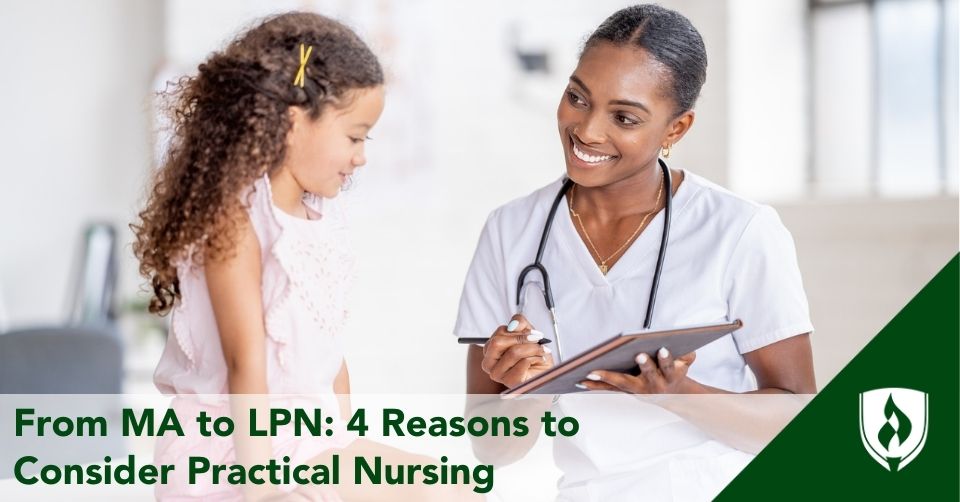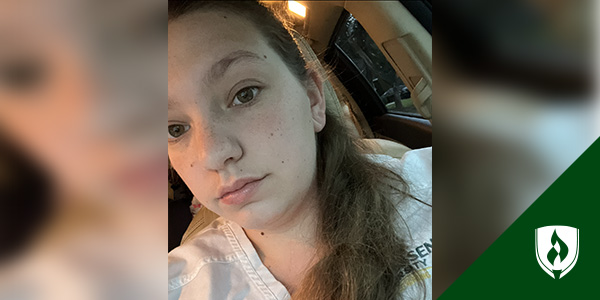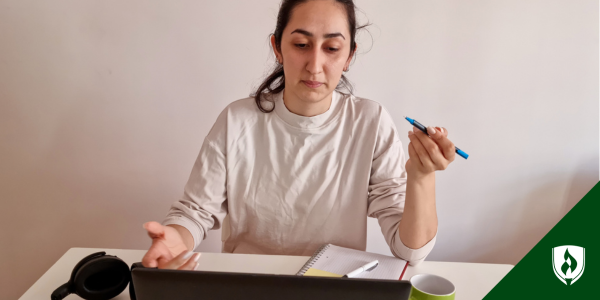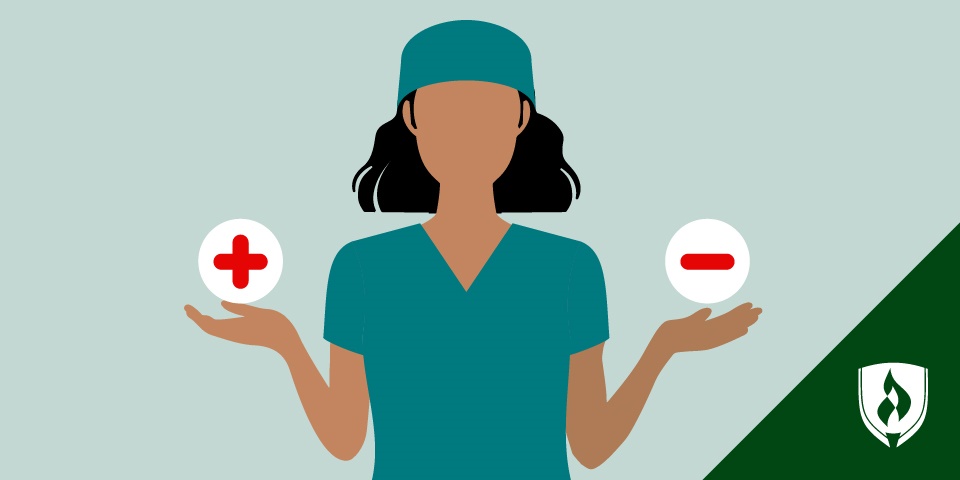
As a medical assistant (MA), you play an important part in your patients’ care. Day in and day out, you can always go home with the knowledge that you’re helping people. And you enjoy working with others in the healthcare field.
But as you progress through your career, you might be looking for a new way to expand—especially doing the type of hands-on, clinical work you like best. Well, a practical nursing option might be something you’d like to pursue.
So, how does the role of a licensed practical nurse (LPN) compare to your current position? What does the path from MA to LPN look like? And what difference could this make for your career?
Here’s what you should know!
1. LPNs have greater responsibilities than medical assistants
Let’s face it: The role of a medical assistant can be pretty limiting. Sure, you get to work with patients, and your work does make a difference. But in terms of hands-on care, a medical assistant just isn’t qualified to do as much as their nursing counterparts.
With that said, these are some duties that typically fall on an LPN’s shoulders, according to the Bureau of Labor Statistics (BLS):1
- Providing basic care—for example, changing bandages or helping with bathing/dressing
- Speaking with patients to discuss their care and any concerns they may have
- Reporting patients’ status updates and concerns to registered nurses (RNs), advanced practice registered nurses (APRNs) and physicians
- Documenting patient care and maintaining accurate health records
- Collecting samples for laboratory tests
Specific duties will naturally vary from state to state as well. For example, the BLS mentions that some states allow LPNs to administer medication or start intravenous (IV) drips.1
So, if it’s more responsibility you’re looking for, then a future in practical nursing is definitely worth considering.
2. An LPN can work in a variety of settings
The vast majority of medical assistants work in physicians’ offices and hospitals.2
But an LPN has a few more options when it comes to work environments. While most licensed practical nurses work for nursing and residential care facilities, according to the BLS, there are lots of other options that might interest you.3
Other common employers include:
- Hospitals
- Home healthcare services
- Physicians’ offices
- Government organizations
- and more!
In fact, LPNs are all over the place! Check out Where Do LPNs Work? 10 Healthcare Settings They Serve In.
3. An LPN can travel for work
If you want to get out there and see the world, that’s all the more reason to consider a practical nursing program.
It’s an unfortunate reality that a country as wealthy as ours still faces a shortage of healthcare professionals. But practical nursing roles offer the opportunity to help alleviate healthcare disparities. As the BLS explains, LPNs can work as travel nurses and provide care throughout the U.S. in regions that don’t have enough healthcare workers.3
4. It’s possible to complete a Practical Nursing (PN) program in as few as 12 months6
The LPN program at Rasmussen University consists of only 15 courses, and full-time students can graduate in as few as 12 months. The curriculum covers everything from anatomy and physiology to mental health nursing.
Some people think the quickest nursing program is going to be an associate degree program. But an LPN program at Rasmussen is actually a nursing diploma program. These programs don't require prior learning in healthcare, but your medical assisting experience will likely make the coursework much more familiar.
Practical Nursing students will prepare to sit for the National Council Licensure Examination for Practical Nurses (NCLEX-PN®). Passing the NCLEX-PN upon successful completion of your program is a key step to becoming a licensed practical nurse.
How do I transition from MA to LPN?
Ready to Take the Next Step?
Explore Rasmussen University's Practical Nursing ProgramAt this point, you’re probably wondering what your own journey from medical assistant to licensed practical nurse will look like. Luckily, the path is fairly straightforward.
First, you’ll need to complete a state board-approved practical nursing program. (You can contact your state’s nursing board to inquire about approved programs.) Since these programs are all about the hands-on skills, you'll need to choose a campus location in your area.
After you conclude your studies, you can apply for licensure/registration with your state’s Nursing Regulatory Body (NRB). From there, you can prepare to sit for the NCLEX-PN, which you’ll need to pass to obtain licensure.
Depending on your specific career goals, you may then choose to pursue cardiopulmonary resuscitation (CPR) and/or basic life support (BLS) certification. In addition, LPNs may pursue certifications in specialty areas like gerontology, wound care, and IV therapy, as the BLS states.4
Additional specific education and/or clinical work experience may be required to become eligible to sit for certification examinations in gerontology, wound care and IV therapy. It is important to check with state agencies and certifying organizations regarding the specific state requirements.
Is practical nursing a good move for you?
If working as a medical assistant has you craving new opportunities, a role in the practical nursing field could be just what the doctor ordered! You’ll gain helpful new knowledge, expand on your current duties and work more closely with patients and families.
Plus, the BLS projects that residential care facilities will have a growing need for practical nursing professionals as more baby boomers enter old age.5
Find out all the important details about LPN programs, such as program costs, available grants, campus locations and more at Rasmussen's Practical Nursing program page.
Learn More & Apply.
Rasmussen University's Practical Nursing ProgramOr, get a good look at what an LPN program would really involve at What Is an “LPN Degree?” A Closer Look at the Training.
NCLEX-PN® is a registered trademark of National Council of State Boards of Nursing, Inc.
1U.S. Bureau of Labor Statistics, Licensed Practical and Licensed Vocational Nurses, [Accessed January 2025] Employment conditions in your area may vary. https://www.bls.gov/ooh/healthcare/licensed-practical-and-licensed-vocational-nurses.htm#tab-2
2U.S. Bureau of Labor Statistics, Medical Assistants, [Accessed January 2025] https://www.bls.gov/ooh/healthcare/medical-assistants.htm#tab-3 Employment conditions in your area may vary.
3U.S. Bureau of Labor Statistics, Licensed Practical and Licensed Vocational Nurses, [Accessed January 2025] https://www.bls.gov/ooh/healthcare/licensed-practical-and-licensed-vocational-nurses.htm#tab-3 Employment conditions in your area may vary.
4U.S. Bureau of Labor Statistics, Licensed Practical and Licensed Vocational Nurses, [Accessed January 2025] Employment conditions in your area may vary.
5U.S. Bureau of Labor Statistics, Licensed Practical and Licensed Vocational Nurses, [Accessed January 2025] https://www.bls.gov/ooh/healthcare/licensed-practical-and-licensed-vocational-nurses.htm#tab-6 Employment conditions in your area may vary.
6Completion time is dependent on the number of transfer credits accepted and the number of courses completed each term. Employment conditions in your area may vary.




